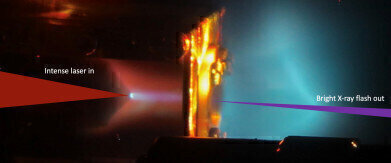-
 A typical image of the ultrashort X-ray burst being generated. An intense laser beam enters a gas cell (from the left and the resulting X-rays exit though a pinhole (to the right). Credit: Brendan Kettle
A typical image of the ultrashort X-ray burst being generated. An intense laser beam enters a gas cell (from the left and the resulting X-rays exit though a pinhole (to the right). Credit: Brendan Kettle -
.jpg) Gemini is a high power, ultra-short pulse laser system delivering dual beams at a rate of one shot every 20 seconds, allowing scientists to study the way matter behaves under extreme conditions of temperature and pressure Credit: STFC
Gemini is a high power, ultra-short pulse laser system delivering dual beams at a rate of one shot every 20 seconds, allowing scientists to study the way matter behaves under extreme conditions of temperature and pressure Credit: STFC -
.jpg)
News
X-ray Technique Probes Conditions in Hot Matter
Jan 18 2020
Researchers have been able to demonstrate a laser-driven X-ray absorption spectroscopy technique that will improve the study of extremely dense and hot matter, such as can be found inside gas giant planets or on the crusts of dead stars, or that is crucial for fusion power.
The technique*, which would be able to use a single X-ray flash to capture information, was developed by a team led by Imperial College London scientists working with colleagues including those at the UK’s Central Laser Facility (CLF) at the Science and Technology Facilities Council (STFC) Rutherford Appleton Laboratory.
The project, funded by the European Research Council, used the CLF Gemini Laser which has two beams – one that can create the conditions for warm dense matter and one which can create ultrashort and bright x-rays to probe the conditions inside the sample.
First author Dr Brendan Kettle, from the Department of Physics at Imperial, said: “We will now be able to probe warm dense matter much more efficiently and in unprecedented resolution, which could accelerate discoveries in fusion experiments and astrophysics, such as the internal structure and evolution of planets including the Earth itself.”
The technique could also be used to probe fast-changing conditions inside new kinds of batteries and memory storage devices.
Previous attempts using lower-powered lasers required 50-100 x-ray flashes to get the same information that the new technique can gain in just one flash. The flashes last only femtoseconds (quadrillionths of a second), meaning the new technique can reveal what is happening within warm dense matter across very short timescales.
In the new study, the team used their technique to examine a heated sample of titanium, successfully showing that it could measure the distribution of electrons and ions.
Lead researcher Dr Stuart Mangles, from the Department of Physics at Imperial, said: “We are planning to use the technique to answer key questions about how the electrons and ions in this warm dense matter ‘talk’ to each other, and how quickly can energy transfer from the electrons to the ions.”
The Central Laser Facility’s Gemini Laser is currently one of the few places the right conditions for the technique can be created, but as new facilities start operating around the world, the team hope the technique can be expanded and used to do a whole new class of experiments.
Dr Rajeev Pattathil, ​​Gemini Group Leader at the Central Laser Facility, said: “With ultrashort x-ray flashes we can get a freeze-frame focus on transient or dynamic processes in materials, revealing key new fundamental information about materials here and in the wider Universe, especially those in extreme states.”
* ‘Single-shot multi-keV X-ray absorption spectroscopy using an ultrashort laser wakefield accelerator source’ by B. Kettle et al. is published in Physical Review Letters.
Digital Edition
Lab Asia Dec 2025
December 2025
Chromatography Articles- Cutting-edge sample preparation tools help laboratories to stay ahead of the curveMass Spectrometry & Spectroscopy Articles- Unlocking the complexity of metabolomics: Pushi...
View all digital editions
Events
Jan 21 2026 Tokyo, Japan
Jan 28 2026 Tokyo, Japan
Jan 29 2026 New Delhi, India
Feb 07 2026 Boston, MA, USA
Asia Pharma Expo/Asia Lab Expo
Feb 12 2026 Dhaka, Bangladesh


















